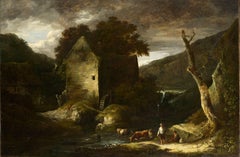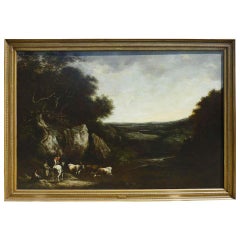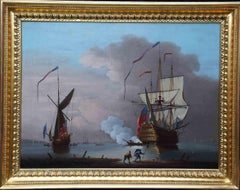Benjamin Barker of Bath Art
British, 1776-1838
Benjamin Barker was an English landscape painter. He was the son of Benjamin and brother of Thomas Barker. Called Barker of Bath, he resided at Bath, Somerset and between 1800–21, exhibited occasionally at the Royal Academy of Arts. During 1813–20, he was a large exhibitor of views and landscape compositions at the Royal Watercolour Society. Barker was also an exhibitor at the British Institution. There are three of his watercolor drawings in the South Kensington Museum. Barker died at Totnes on 2 March 1838, aged 62. Thales Fielding engraved 48 of his landscapes in aquatint.
to
1
3
2
3
1
2
Overall Height
to
Overall Width
to
2
3
2
1
1
1
2
1
2
3
6,910
3,236
2,514
1,217
3
3
Artist: Benjamin Barker of Bath
Figures resting by a fire with a wagon in a wooded landscape
By Benjamin Barker of Bath
Located in Stoke, Hampshire
Benjamin Barker of Bath (Pontypool 1776-1838)
Figures resting by a fire with a wagon in a wooded landscape
Oil on canvas
28 x 35 7/8 in
71.1 x 91.2 cm
Benjamin Barker, the younger ...
Category
18th Century Old Masters Benjamin Barker of Bath Art
Materials
Oil
A large wooded river landscape with drovers
By Benjamin Barker of Bath
Located in Stoke, Hampshire
Benjamin Barker of Bath (Pontypool 1776-1838)
A wooded river landscape with drovers
Signed and dated 'B.Barker pinxt/ 1807' lower right
Oil on canvas
46 x 68 3/4 in (116.8 x 174.5 cm...
Category
18th Century Old Masters Benjamin Barker of Bath Art
Materials
Oil
Benjamin Barker Of Bath, Landscape With Cattle, Oil On Canvas Signed, Dated 1810
By Benjamin Barker of Bath
Located in Lincoln, GB
Benjamin Barker of Bath (1776–1838) Landscape with cattle Oil on canvas
Signed and dated 1810 178 x 266 cm / 203 x 297 cm framed
This very large impressive landscape by this impor...
Category
1810s Benjamin Barker of Bath Art
Materials
Oil
Related Items
Morning Gun - British Old Master naval marine seascape ships art oil painting
By Peter Monamy
Located in London, GB
This superb British Old Master marine oil painting is attributed to Peter Monamy. Painted circa 1730 it depicts Morning Gun - A morning gun is a gun fired at the first note of revei...
Category
1730s Old Masters Benjamin Barker of Bath Art
Materials
Oil
Castle and River Landscape - British 19thC art oil painting follower of Turner
Located in London, GB
This stunning large 19th century landscape oil painting is attributed to follower of Joseph Turner, possible George William Mote. Painted circa 1850 it is a panoramic landscape loo...
Category
1850s Old Masters Benjamin Barker of Bath Art
Materials
Oil
Allegory of Abundance
Located in New York, NY
Painted in collaboration with Hendrick van Balen (Antwerp, 1575 – 1632).
Provenance: Private Collection, Uruguay, since the 1930s.
The eldest son of Jan Br...
Category
17th Century Old Masters Benjamin Barker of Bath Art
Materials
Copper
Wooded Landscape - British art 18thC Old Master oil painting trees figures
By Thomas Gainsborough (circle)
Located in London, GB
A delightful painting, oil on paper laid on panel, with beautiful Gainsboresque colouring. This is a fine Old Master circa 1770 landscape in the 18th century Romantic landscape tradi...
Category
18th Century Old Masters Benjamin Barker of Bath Art
Materials
Oil
Villagers in a Landscape - Flemish 17thC art figurative landscape oil painting
Located in London, GB
This fantastic Flemish 17th century Old Master oil painting is by Thomas Van Apshoven. It was painted circa 1650 and depicts a village with figures outside a tavern, eating, drinking and dancing. Beyond are more dwellings, villagers and animals, all under a blue summer's sky. The detail, brushwork and vibrant colouring are superb. This is an excellent example of Apshoven's work and a typical subject he loved to paint.
Provenance. Leominster estate.
Wax stamp verso.
Condition. Oil on panel, 22 inches by 17 inches and in good condition.
Frame. Housed In beautiful gilt frame, 30 inches by 25 inches and in good condition.
Thomas van Apshoven (1622– 1664) was a Flemish painter known for his landscapes with peasant scenes and genre scenes in interiors. His genre scenes depict village festivals, the interiors of taverns, village scenes or landscapes with peasants engaged in various activities, singeries, guardroom scenes and laboratories of alchemists. Some still lifes have also been attributed to him. His themes and style are close to that of David Teniers the Younger. He was born on 30 November 1622 in Antwerp as the eldest son of Ferdinand van Apshoven the Elder and Leonora Wijns. His father was a painter who had studied with Adam van Noort and had become a master of the Antwerp Guild of Saint Luke in 1596. No paintings by his father are known. His younger brother Ferdinand van Apshoven the Younger became also a successful painter. Thomas studied under his father. Some sources state that he became a pupil of the prominent genre painter David Teniers the Younger. It is more likely, however, that he was an imitator of Teniers. He was registered as a 'wijnmeester' [son of a master] in the Guild of St. Luke of Antwerp in the guild year 1645–1646. He married Barbara Janssens on 22 March 1645. The couple had four children. The godfathers of the children included the painters Victor Wolfvoet...
Category
1650s Old Masters Benjamin Barker of Bath Art
Materials
Oil
Manor House with Cottages - British 18thC Old Master art oil painting VG prov.
By George Lambert
Located in London, GB
This stunning British Old Master landscape oil painting, with excellent provenance, is by George Lambert. Lambert was a pioneer of British landscape in art for its own sake. Painted in 1744, the painting is entitled View of a Manor House and Cottages in Elizabeth Einberg's 63rd volume of the Walpole Society 2001 and is described as follows: In the foreground a road emerges from a wood to cross a ford and then leads up the hill to the right, towards a manor house seemingly built into the remains of a medieval or Tudor edifice. The main track, crowded with sheep and rustic figures, passes the massive square gateposts lower down the hill on the left. Further to the left is a thatched cottage with smoke coming out the chimney. In the distance is a wide coastal view. The main buildings, which are in the dead centre of the composition, represent almost certainly an as yet unidentified English view.
The colouring and detail in the trees and foliage are superb. This is an excellent Old Master oil painting by one of the all time great British landscape artists with extensive provenance.
Signed and dated 1744 lower left on rock in black.
Provenance. Elizabeth Einberg, “Catalogue Raisonnè of the works of George Lambert” The Annual Volume of the Walpole Society, 2001 Vol. 63, page 149 no P1744, fig.71.
Antonacci Efrati Antichità Rome Gallery.
Burden sale, Parke Bernet, New York, 20-21, April 1938 (376 repr.)
Robert E. Peters, Sotheby Parke Bernet, New York, March 1975 (41 repr.)
Lit. Schnackenburg 1995, pp 83-84, cat. no.14 fig 13.
Condition. Oil on canvas, 54 inches by 52 inches and in good condition.
Frame. Housed in an ornate gilt frame, 64 inches by 62 inches and in good condition.
George Lambert (1700-1765) was an English landscape artist and theatre scene painter. With Richard Wilson he is recognised as a pioneer of British landscape in art, for its own sake. Lambert was born in Kent and studied art under Warner Hassells and John Wootton, soon attracting attention by the quality of his landscape painting. He painted many large and fine landscapes in the style of Gaspar Poussin and Salvator Rosa. Many of his landscapes were finely engraved by François Vivares, James Mason (1710–1785), and others, including a set of views of Plymouth and Mount Edgcumbe (painted conjointly with Samuel Scott), a view of Saltwood Castle in Kent, another of Dover, and a landscape presented to the Foundling Hospital in London. Lambert also obtained a great reputation as a scene-painter, working at first for the Lincoln's Inn Fields Theatre, in London, under John Rich. When Rich moved to Covent Garden Theatre, Lambert secured the assistance of Amigoni, and together they produced scenery of far higher quality than any previously executed. Lambert was a man of jovial temperament and shrewd wit, and frequently spent his evenings at work in his painting-loft at Covent Garden Theatre, to which men of note in the fashionable or theatrical world resorted to share his supper of a beef-steak, freshly cooked on the spot. Out of these meetings arose the well-known "Beefsteak Club" which long maintained a high social reputation. Most of Lambert's scene-paintings unfortunately perished when Covent Garden Theatre was destroyed by fire in 1808. Lambert was a friend of William Hogarth and a member of the jovial society that met at 'Old Slaughter's' Tavern in St Martin's Lane. In 1755 he was one of the committee of artists who proposed a royal academy of arts in London. He was a member of the Society of Artists of Great Britain, exhibited with them in 1761 and the three following years, and during the same period contributed to the Academy exhibitions. In 1765 he and other members seceded and formed the Incorporated Society of Artists of Great Britain, of which he was elected the first president. In conjunction with Samuel Scott, Lambert painted a series of Indian views for the old East India House in Leadenhall Street. He also etched two prints after Salvator Rosa. Lambert was associated in 1735 with George Vertue, Hogarth, and John Pine (engraver, 1660–1756) in obtaining a bill from parliament securing artists a copyright on their works. Lambert's portraits were painted by Thomas Hudson, John Vanderbank (engraved in mezzotint by John Faber the younger in 1727, and in line by H. Robinson and others), and Hogarth. Lambert's most famous painting is "A view of Box Hill, Surrey" (1733) which depicts a well-known beauty spot south of London. Hogarth considered Lambert a rival to the famous French landscape painter Claude Lorrain (1600–1682) with respect to his use of soft light to unify the scene in this painting. Though he never visited Italy he was inspired by the classical tradition of landscape painting. Lambert died on 30 November 1765 at his home on the Piazza in Covent Garden. His pupils included John Inigo Richards...
Category
Mid-18th Century Old Masters Benjamin Barker of Bath Art
Materials
Oil
Antique battle painter - 17th century figure painting Battle Knight
By Jacques Courtois
Located in Varmo, IT
Jacques Courtois, known as il Borgognone (Saint-Hyppolite 1621 - Rome 1676) circle of - Battaglia.
53 x 80 cm without frame, 73.5 x 97.5 cm with frame.
Antique oil painting on canv...
Category
Late 17th Century Old Masters Benjamin Barker of Bath Art
Materials
Oil, Canvas
Early oil depicting the Great Fire of London
Located in London, GB
The Great Fire of London in September 1666 was one of the greatest disasters in the city’s history. The City, with its wooden houses crowded together in narrow streets, was a natural fire risk, and predictions that London would burn down became a shocking reality. The fire began in a bakery in Pudding Lane, an area near the Thames teeming with warehouses and shops full of flammable materials, such as timber, oil, coal, pitch and turpentine. Inevitably the fire spread rapidly from this area into the City. Our painting depicts the impact of the fire on those who were caught in it and creates a very dramatic impression of what the fire was like. Closer inspection reveals a scene of chaos and panic with people running out of the gates. It shows Cripplegate in the north of the City, with St Giles without Cripplegate to its left, in flames (on the site of the present day Barbican). The painting probably represents the fire on the night of Tuesday 4 September, when four-fifths of the City was burning at once, including St Paul's Cathedral. Old St Paul’s can be seen to the right of the canvas, the medieval church with its thick stone walls, was considered a place of safety, but the building was covered in wooden scaffolding as it was in the midst of being restored by the then little known architect, Christopher Wren and caught fire. Our painting seems to depict a specific moment on the Tuesday night when the lead on St Paul’s caught fire and, as the diarist John Evelyn described: ‘the stones of Paul’s flew like grenades, the melting lead running down the streets in a stream and the very pavements glowing with the firey redness, so as no horse, nor man, was able to tread on them.’
Although the loss of life was minimal, some accounts record only sixteen perished, the magnitude of the property loss was shocking – some four hundred and thirty acres, about eighty per cent of the City proper was destroyed, including over thirteen thousand houses, eighty-nine churches, and fifty-two Guild Halls. Thousands were homeless and financially ruined. The Great Fire, and the subsequent fire of 1676, which destroyed over six hundred houses south of the Thames, changed the appearance of London forever. The one constructive outcome of the Great Fire was that the plague, which had devastated the population of London since 1665, diminished greatly, due to the mass death of the plague-carrying rats in the blaze.
The fire was widely reported in eyewitness accounts, newspapers, letters and diaries. Samuel Pepys recorded climbing the steeple of Barking Church from which he viewed the destroyed City: ‘the saddest sight of desolation that I ever saw.’ There was an official enquiry into the causes of the fire, petitions to the King and Lord Mayor to rebuild, new legislation and building Acts. Naturally, the fire became a dramatic and extremely popular subject for painters and engravers. A group of works relatively closely related to the present picture have been traditionally ascribed to Jan Griffier...
Category
17th Century Old Masters Benjamin Barker of Bath Art
Materials
Canvas, Oil
Cattle and Drover in a Landscape - British Victorian art landscape oil painting
Located in London, GB
This gorgeous oil on canvas Victorian Old Master painting is by British artist Henry Jutsum. Painted circa 1850 the painting depicts a drover on horse back bringing up the rear behin...
Category
19th Century Old Masters Benjamin Barker of Bath Art
Materials
Oil
A Wolf
Located in New York, NY
Provenance:
The Marchesi Strozzi, Palazzo Strozzi, Florence
Sale, Christie’s, London, May 20, 1993, lot 315, as by Carl Borromaus Andreas Ruthart...
Category
17th Century Old Masters Benjamin Barker of Bath Art
Materials
Paper, Canvas, Oil
Macbeth and the Three Witches a Painting on Panel by Francesco Zuccarelli
By Francesco Zuccarelli
Located in PARIS, FR
This painting, created during Zuccarelli's stay in England, represents the decisive moment when Macbeth, together with Banquo, meets the three witches who announce that he will be Ki...
Category
1760s Old Masters Benjamin Barker of Bath Art
Materials
Oil, Wood Panel
17th century Italian figure painting - Fall of Fetonte - Oil on copper Landscape
Located in Varmo, IT
Roman master (c. 1650) - The Fall of Phaeton.
40.5 x 52.5 cm without frame, 56.5 x 59.5 cm with frame.
Oil on copper, in carved and gilded wooden fra...
Category
Mid-17th Century Baroque Benjamin Barker of Bath Art
Materials
Copper
Benjamin Barker Of Bath art for sale on 1stDibs.
Find a wide variety of authentic Benjamin Barker of Bath art available for sale on 1stDibs. You can also browse by medium to find art by Benjamin Barker of Bath in oil paint, paint and more. Much of the original work by this artist or collective was created during the 18th century and is mostly associated with the Old Masters style. Not every interior allows for large Benjamin Barker of Bath art, so small editions measuring 36 inches across are available. Customers who are interested in this artist might also find the work of Charles Towne, Paul Emile Léon Perboyre, and Sir Godfrey Kneller. Benjamin Barker of Bath art prices can differ depending upon medium, time period and other attributes. On 1stDibs, the price for these items starts at $9,696 and tops out at $81,359, while the average work can sell for $23,916.




